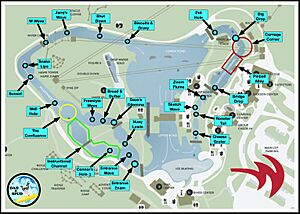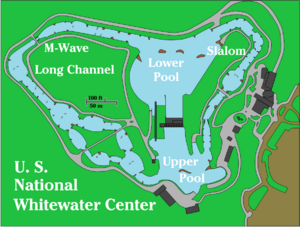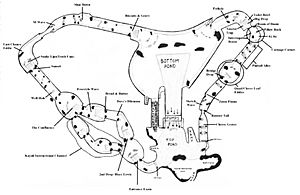U.S. National Whitewater Center facts for kids
Quick facts for kids About |
|
|---|---|
| Locale | Charlotte, North Carolina, USA |
| Managing agent | U. S. National Whitewater Center |
| Main shape | Two Loops |
| Pumped | 7 pumps (usually 6 or 3) |
| Opening date | November 4, 2006 |
| Stats | |
| Length | Slalom: 300 metres (984 ft) Long: 550 metres (1,804 ft) |
| Drop | 6.4 metres (21 ft) |
| Slope | Slalom: 2.1% (113 ft/mi) Long: 1.2% (67 ft/mi) |
| Flowrate | Slalom: 15 m3/s (530 cu ft/s) Long: 19 m3/s (670 cu ft/s) |
The U.S. National Whitewater Center (USNWC) is a super cool place in Charlotte, North Carolina where you can have outdoor adventures! It's a special park for fun and sports training. You can try exciting activities like whitewater rafting, kayaking, canoeing, rock climbing, mountain biking, hiking, and even ice skating. The center first opened its doors in 2006.
This amazing place covers about 1,300 acres (530 ha) of land. It sits right next to the Catawba River. There are also more than 50 miles (80 km) of trails for you to explore. The main attraction here is the world's biggest man-made river for whitewater sports. It's designed to make exciting rapids! An Olympic athlete named Scott Shipley helped design these river channels.
Contents
Awesome Whitewater Rivers
The USNWC has a special river system that reuses its water. It holds 12 million gallons of water! This water is cleaned every day using filters and ultraviolet light. The whitewater part of the river is about 3,750 feet (1,140 m) long. It's split into two main channels.
Two Exciting Channels
One channel is designed for Olympic-style slalom races. The other is a longer "wilderness" channel that goes around an island. The rapids in these channels range from Class II (easy) to Class IV (challenging). You can go down these rapids in a canoe, kayak, or with a guide on a raft. Both channels connect to an Upper and Lower Pool. A moving-belt lift helps boats go between these pools.
How the River Works
The center uses seven powerful pumps to move the water. Each pump is very strong! Usually, three pumps water each channel. Six pumps can run both channels at the same time. When only one channel is in use, a special gate stops water from flowing into the other channel. Both channels have the same drop in height, about 6.4 metres (21 ft). But because the Wilderness Channel is longer, its slope is gentler.
Most of the things that create the rapids are natural rocks cemented in place. There are also some movable plastic barriers. Five special "barn door" gates can be moved by hydraulic systems. These gates help change how the water flows. One cool feature is the M-Wave, which is designed to look like a famous wave in Colorado.
River Rapids and Waves
The Wilderness Channel has six named rapids. These include Entrance Exam (Class 2), Huey Lewis (Class 2), Bread and Butter (Class 2+), Sunset (Class 3), and M-Wave (Class 3+). Kayakers love to surf waves here like Connor's Hole and Freestyle Wave.
The Competition Channel has two main drops: Bridge Drop (Class 3) and Big Drop (Class 4). Popular waves for kayaking here are Cheese Grater and Sketch Wave.
Fun Activities to Try
The USNWC offers tons of activities for everyone!
Water Sports
- Whitewater Rafting – You can go rafting with trained guides on Class II, III, and IV rapids. In 2010, 100,000 people went rafting here!
- Whitewater Kayaking – Whether you're a beginner or an expert, you can kayak here. You might even paddle alongside Olympic athletes! They also have slalom races for all ages.
- Flatwater Kayaking – If you prefer calmer waters, you can kayak on the nearby Catawba River.
- Stand-Up Paddle Boarding – This activity started in 2011. You stand on a board like a surfboard and use a long paddle to move along the Catawba River.
Land Sports
- Ice Skating – Since 2019, the USNWC has had one of the biggest outdoor ice rinks on the East Coast! You can skate on two ice trails or a large open area. There's even a cool Airstream trailer on the ice that serves drinks.
- Mountain Biking – The center has over 50 miles (80 km) of trails for mountain biking. These trails range from easy to advanced. You can bring your own bike or rent one there.
- The Trail System – The same 50 miles (80 km) of trails are also great for running and walking. Many races happen here, like the Whitewater Race Series.
- Rock Climbing – The USNWC has one of the largest outdoor climbing centers in the world. It has over 40 climbing routes and reaches a height of 46 feet (14 m).
Aerial Sports
- Canyon Crossing – This activity opened in 2011. It's a circuit of sky bridges with five different challenges. You'll be over 50 feet (15 m) high above a gorge! It ends with a 250-foot (76 m) zip-line ride back across.
- Adventure Course – This is an obstacle course high up in the trees, about 20 feet (6 m) off the ground.
- Canopy Tour – Also opened in 2011, this tour takes you through the treetops. It has 14 tree platforms connected by seven zip-lines and sky bridges. You'll reach heights over 60 feet (18 m) and travel over wetlands and a 90-foot (27 m) deep canyon. Guides will teach you about the area as you go!
Images for kids
External links












